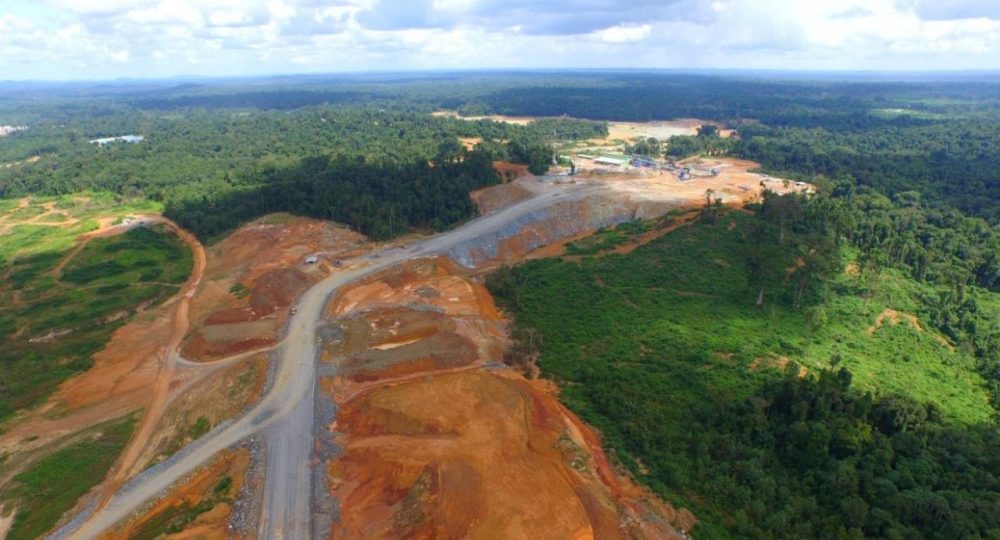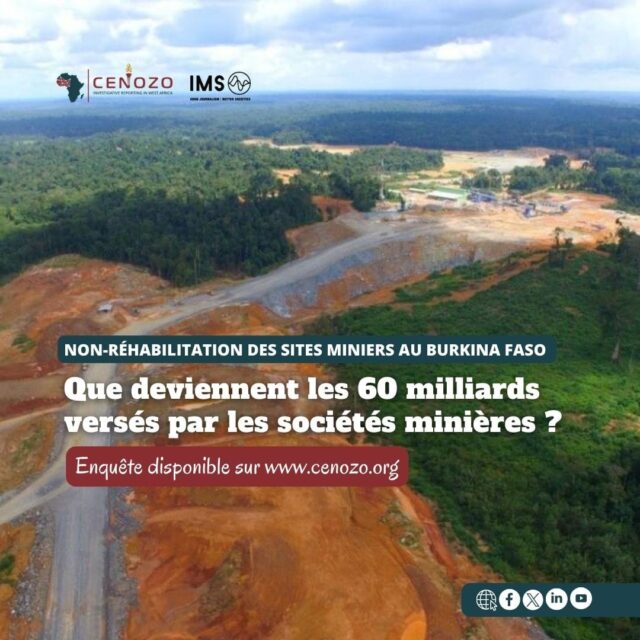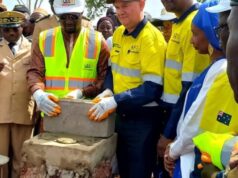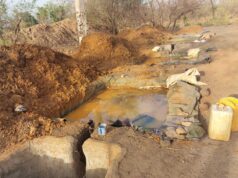The various Mining Codes adopted by Burkina Faso provide a framework for the closure and rehabilitation of mining sites. Indeed, when mining companies come to the end of their operations, they are obliged to rehabilitate the areas where they used to operate. To do this, they pay annual contributions during the operating phase of their mine so that this financial windfall can be used for rehabilitation. Despite this, not a single site has been rehabilitated. So, what is the point of the mining companies’ contributions? What has become of these billions of FCFA? Why have the sites not been rehabilitated, despite the billions of FCFA paid by the mining companies? We set out to understand why it is impossible to rehabilitate closed mining sites in Burkina Faso.
Mining has a significant impact on the environment. At the end of a mine’s life, however, the company is obliged to carry out backfilling work, re-covering the land using the materials used to backfill the quarry floor, excavations and pits, and reconstituting the biotope base by planting different species, and so on. To cover the costs of these various operations to restore the environment and the setting used for mining activities, the Mining Code requires each mining operator to set up an account with the BCEAO or a commercial bank, where they pay contributions based on the elements contained in the environmental and social management plan. These contributions will be used for all rehabilitation activities.

The Mining Code adopted in 2015 was clear on the issue. Indeed, article 141 of Act No. 036-CNT on the Mining Code stipulates that “any holder of a large or small mining permit, a semi-mechanised mining permit or an authorisation for the industrial exploitation of quarry substances is obliged to open and feed the mine, a semi-mechanised exploitation permit or an authorisation for the industrial exploitation of quarry substances is required to open and fund a fiduciary account at the Central Bank of West African States (Banque centrale des Etats de l’Afrique de l’Ouest – BCEAO) or at a commercial bank in Burkina Faso, which will be used to set up a fund to cover the costs of implementing the environmental preservation and rehabilitation programme. The sums thus used are exempt from income tax. The procedures for replenishing and managing this fund shall be established by regulation”.
The Environmental Intervention Fund (Fonds d’intervention pour l’environnement – FIE) is responsible for managing the funds contributed by mines. The FIE “mobilises and manages the fund. He worked to open the accounts ” for mining companies, explain FIE officials. In addition, Decree n°2017-0047/PRES/PM/MEMC/ MEEVCC/MINEFID/MATDS 15 February 2017, on the organisation, operation and procedures for collecting resources from the Mine Rehabilitation and Closure Fund, specifies the conditions for supplying the account as well as the conditions for using the funds paid into it.
Billions of FCFA in the bank
According to information obtained from the Extractive Industries Transparency Initiative (EITI-BF), mining companies have paid their dues. In 2016, for example, the overall balance of their contributions was only 9,110,134,041 FCFA compared with 23,950,892,373 FCFA expected at the end of 2015, according to EITI-BF figures. This already meant a shortfall of 14,840,758,332 FCFA.
Subsequently, the situation seems to have evolved to a greater or lesser extent. By 31 December 2022, according to the EITI’s 2023 progress report, contributions had been made by 11 mining companies to a total of 57,128,711,498 FCFA. By the same date, however, mining companies were expected to have contributed 60,640,610,823 FCFA. At the end of 2022, the shortfall is 3,511,899,325 FCFA. This means that the rehabilitation fund is not yet fully operational, despite the efforts of the mining companies. Nevertheless, “it is important to stress that all mining companies are contributing”, says EITI-Burkina.
For 2023, some companies have already made payments into the Fund. At the end of the first half of 2023, the FIE has learned that 12 companies have paid their contributions to the fund for the rehabilitation and closure of mining sites. All contributions since the Rehabilitation Fund’s inception in 2015 amount to 60,933,070,629 FCFA as at 30 June 2023.
Impossible rehabilitation?
However, the rehabilitation of mining sites in Burkina Faso is encountering difficulties, if not blockages, according to FIE officials. They confirm that the mines that have been closed have not yet been rehabilitated. According to information from EITI-Burkina, there are currently “6 mines at a standstill for various reasons”, not closed mines.
Some mining companies have their rehabilitation plans, but are having difficulty having them examined by a Committee. Indeed, rehabilitation and closure plans for industrial and semi-mechanised mines and industrial quarries are examined and approved by the Interministerial Technical Committee for the Examination of Mine Rehabilitation and Closure Plans and Programmes.
This Committee was created by interministerial order n°2019-554/MEEVCC/MMC/ MINEFID/MATDCS of 30 October 2019. Composed of 24 members, it is chaired by the Secretary General of the Ministry in charge of the Environment. The members were officially installed on 9 December 2020. The procedure is for each mine to send its rehabilitation plan to the Minister of Mines, who then refers the matter to the Chairman of the Committee for a ruling. Unfortunately, according to FIE officials, as of 30 June 2023, no mine rehabilitation or closure plan has been submitted to the Committee.
The IEF blames “the lack of resources for the operation of the committee set up”. In addition, the lack of resources needed to run the committees that have been set up, the lack of regulations governing access to resources, and the fact that the committees responsible for examining and validating mine rehabilitation and closure plans and programmes have not been set up are all barriers to the implementation of mine site rehabilitation, according to the IEF’s experts.
Indeed, article 21 of Order No. 2019-554/MEEVCC/MMC/MINEFID/MATDCS states that “the operating costs of the CT/EV and the Interministerial Monitoring and Control Committee are borne by the Mine Rehabilitation and Closure Fund”. And article 22 adds that “the session allowances of the members of the CT/EV, the mission expenses of the members of the Interministerial Monitoring and Control Committee and the session allowances of the Board of Directors of the Environmental Intervention Fund are paid in accordance with the texts in force”. The text does not therefore specify the source of the allowances and other expenses, since the activities financed by contributions are clearly mentioned in the decree.
Is there a problem with the way the Committee members are supported? No, replies an EITI-Burkina technician. Before him, we tried to put the same question to the direct actors of the State, but our requests for interviews with the Ministry of Mines, the Ministry of the Environment and the National Agency for Environmental Assessments, all dated 5 July 2023, were not answered.
One of the major difficulties, according to our source at EITI-Burkina, is having access to experienced human resources to carry out fieldwork and assess the real impact of mining activities before being able to evaluate any proposals for site rehabilitation plans. Added to this, he confides, is the security issue, which does not facilitate work of this type.
Nevertheless, according to Environmental Inspector Juste Bationo, the issue of funding for members of the Technical Committee remains a reality. He explains the link with the issues of assumption of responsibility through the regulatory provisions that govern the conditions for the disbursement of funds.
According to him, there are a number of conditions to be met: “Expenditure on the rehabilitation and closure of mining sites can only be authorised once an accurate assessment of the cost of rehabilitating and closing mining sites has been carried out, the technical committee’s assessment report highlighting the conclusions of the work, the final opinion, the list of members who took part in the work and the final version of the rehabilitation and closure plan have been submitted to the FIE’s Board of Directors, and a report on the physical and financial execution of the work for the previous year has been drawn up, if applicable. “
This authorisation of rehabilitation expenditure is ensured by the interministerial technical committee responsible for evaluating and validating rehabilitation plans. As a result, it is difficult for the Administration “to release the funds needed to hold the validation sessions for the annual rehabilitation and closure plans and programmes”. According to the Acting Director General of the FIE, a solution must be found quickly to the various difficulties associated with the rehabilitation of mines.
To find out what was holding things up, we wrote to the Ministry of the Environment, the Ministry of Mines and the Committee. But to date, we have received no response.
Faced with all these difficulties in the system, we learn that a review of the texts governing rehabilitation is underway to make the Committee more operational. This will enable the new realities to be taken into account. In addition, the players agree that it would be wise to envisage a gradual rehabilitation of the mines.
Deplorable environmental situation
Clearly, as long as the sites are not rehabilitated, the environmental situation at mining sites remains a cause for concern. If the sites are not rehabilitated, the consequences are enormous. According to an EITI expert, non-rehabilitation causes problems for the surrounding population. Tailings ponds laden with toxic chemicals such as cyanide, he says, can contaminate the water table, and gaping holes threaten people’s physical safety.
The Kalsaka mine in the North region is a case in point. Closed since 2013, the mine’s failure to rehabilitate has led to fears of the worst. Animals have died inside the site, which has been ransacked by the local population, according to the former mayor. The Poura mine is also a perfect example. It has not been rehabilitated since its closure in 1999. According to eyewitness accounts, the underground water in the town of Poura has been contaminated by toxic products. Dozens of animals died after drinking the contaminated water.
The Perkoa zinc mine and the idled Youga gold mine are in danger of suffering the same fate if rehabilitation is not carried out. Yet all these mines have paid their contributions to the rehabilitation fund. Better still, Kalsaka and Essakane submitted their rehabilitation plans in August 2015 and November 2020 respectively. Kalsaka’s and Essakane’s files have never been sent to this Committee, let alone examined. These 02 companies, which are up to date with their contributions to the mine rehabilitation and closure fund, do not have access to it to begin rehabilitation.
The lack of resources was undermined by a survey carried out in 2016 by members of the seventh parliament. According to the MPs, “mining companies are falling short of the environmental responses that are legally and socially expected”. The MPs also deplored the fact that the Ministries of Mines and the Environment showed no real willingness “to take the necessary corrective measures”.
Worse still, because the State did not use the funds, some mining companies wanted to use their bank deposits to implement their environmental and social management plan (ESMP), which is different from the closure and rehabilitation plan.
This lack of financial resources is also challenged by many observers of the mining sector, who believe that there are several ways of financing the Committee’s operations. The financial departments of the Ministry of the Environment can apply for resources from the interdepartmental expenditure section of the national budget. This can be done by making a request to the Ministry of Finance or by creating a line in the annual budget.
Survey conducted by Aimé Kobo NABALOUM with the support of the Norbert Zongo Unit for Investigative Journalism in West Africa (CENOZO).










